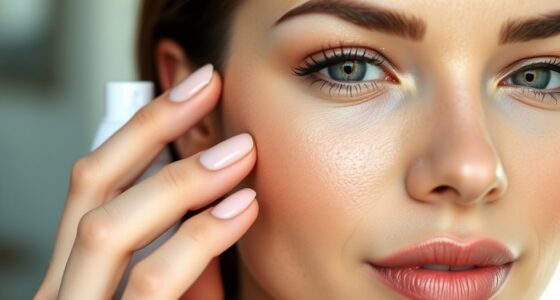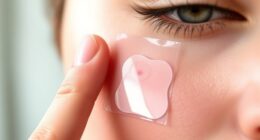To craft a skin cycling routine that delivers results without burnout, rotate exfoliation nights with recovery days, focusing on gentle cleansing, nourishing, and hydrating ingredients. Use chemical exfoliants like AHAs or BHAs a few times a week, but avoid overdoing it to prevent irritation. Incorporate rest days to allow your skin to recover and adapt. If you want to master the art of effective, sustainable skincare, more tips await you.
Key Takeaways
- Designate specific nights for exfoliation to prevent overloading skin and promote recovery.
- Alternate active ingredients with calming or hydrating products to minimize irritation and support skin health.
- Incorporate rest days between active treatment nights to allow skin to repair and reduce sensitivity.
- Use chemical exfoliants like AHAs or BHAs strategically, not daily, to boost cell turnover safely.
- Maintain consistency with the routine, focusing on patience and long-term skin health rather than immediate results.

Have you heard of skin cycling? It’s a skincare approach that helps you maximize your routine’s effectiveness while giving your skin time to recover. Instead of overloading your skin with products every day, skin cycling involves rotating through different steps—like cleansing, exfoliating, and moisturizing—in a planned sequence. One key component of this method is understanding how to incorporate chemical exfoliation safely and effectively. Chemical exfoliants, such as AHAs and BHAs, help remove dead skin cells, revealing a brighter, smoother complexion. But using them daily can sometimes cause irritation or sensitivity, especially if you’re also layering active ingredients. That’s where ingredient layering becomes vital. Instead of applying multiple potent products at once, skin cycling encourages you to alternate your exfoliating acids with nourishing, calming ingredients on different nights. This way, your skin gets the benefits of exfoliation without the risk of overdoing it or causing damage.
When you follow a skin cycling routine, you typically designate specific nights for exfoliation, allowing your skin to shed dead cells and promote cell turnover. On these exfoliation nights, chemical exfoliation takes center stage, breaking down the bonds holding dead skin in place. But it’s important to remember that ingredient layering should be approached thoughtfully. For instance, after an exfoliation night, you might focus on hydrating ingredients like hyaluronic acid or soothing agents like niacinamide. On other nights, you can incorporate actives like retinoids or vitamin C, but not on the same night as exfoliating acids. This prevents irritation and guarantees your skin isn’t overwhelmed by multiple potent ingredients at once. Incorporating proper skincare strategies can further enhance your routine and ensure your skin’s health and safety.
The beauty of skin cycling lies in its simplicity and flexibility. By planning your routine around rest days for your skin, you reduce the likelihood of redness, dryness, or breakouts caused by overuse of active ingredients. It’s a way to get the most out of your skincare products without risking burnout or harm. Plus, it helps you become more aware of how your skin responds to different ingredients, making it easier to customize your routine over time. Remember, patience is key. When you give your skin time to adapt and recover, the results you see—like improved texture, clarity, and radiance—will be more sustainable and healthier in the long run.
Frequently Asked Questions
Can Skin Cycling Suit All Skin Types?
You wonder if skin cycling suits all skin types. While it benefits many, it’s not universal. Your skin type compatibility influences how you customize your routine. Sensitive skin might need gentler products, while oily or acne-prone skin may require specific treatments. You should adapt the cycling schedule to your skin’s needs, ensuring you avoid irritation or over-exfoliation. Personalization helps maximize results and keeps your skin healthy.
How Long Before Seeing Visible Results?
Wondering how long you’ll wait for those visible improvements? Well, patience is key—timing expectations vary, but most folks see initial changes within 4 to 6 weeks. Don’t expect a miracle overnight; skin’s a slow learner. Keep at your routine, and with consistency, you’ll notice subtle shifts that hint at future glow-ups. Remember, good things take time, even for your skin’s version of a glow-up.
Are There Any Risks or Side Effects?
You might experience some potential irritation or allergy risks when starting skin cycling, especially if you’re sensitive to certain products. It’s important to patch-test new ingredients and follow your routine carefully. While side effects are usually mild, watch for redness, itching, or discomfort. If you notice any adverse reactions, reduce frequency or consult a dermatologist. Being cautious helps you enjoy the benefits without risking unnecessary irritation or allergy issues.
Can Skin Cycling Replace My Current Skincare Routine?
Oh, sure, replacing your entire routine with skin cycling sounds tempting—like swapping out a well-crafted meal for just dessert. But honestly, it’s all about ingredient focus and routine customization. Skin cycling can complement your current routine, not replace it. You need a tailored plan that targets your needs without throwing out your favorite steps. Remember, your skin’s a unique snowflake, not a one-size-fits-all experiment.
How Should I Adjust the Routine During Different Seasons?
You should adjust your routine based on seasonal skincare and climate considerations. In colder months, add more moisturizing products and reduce exfoliation to protect your skin from dryness. During warmer seasons, incorporate lighter textures and sun protection. Pay attention to how your skin reacts, and tweak your routine accordingly. This approach guarantees your skin stays balanced and healthy throughout the year, preventing burnout and optimizing results.
Conclusion
By embracing skin cycling, you’re not just following a routine—you’re creating a masterpiece of self-care. With balance and consistency, you reveal radiant results without risking burnout. Remember, your skin’s health is a marathon, not a sprint. So, why rush when you can nurture and nurture again? Think of your routine as a symphony—each note essential, each moment intentional. When you harmonize these elements, glowing skin becomes not just a goal, but your reality.










